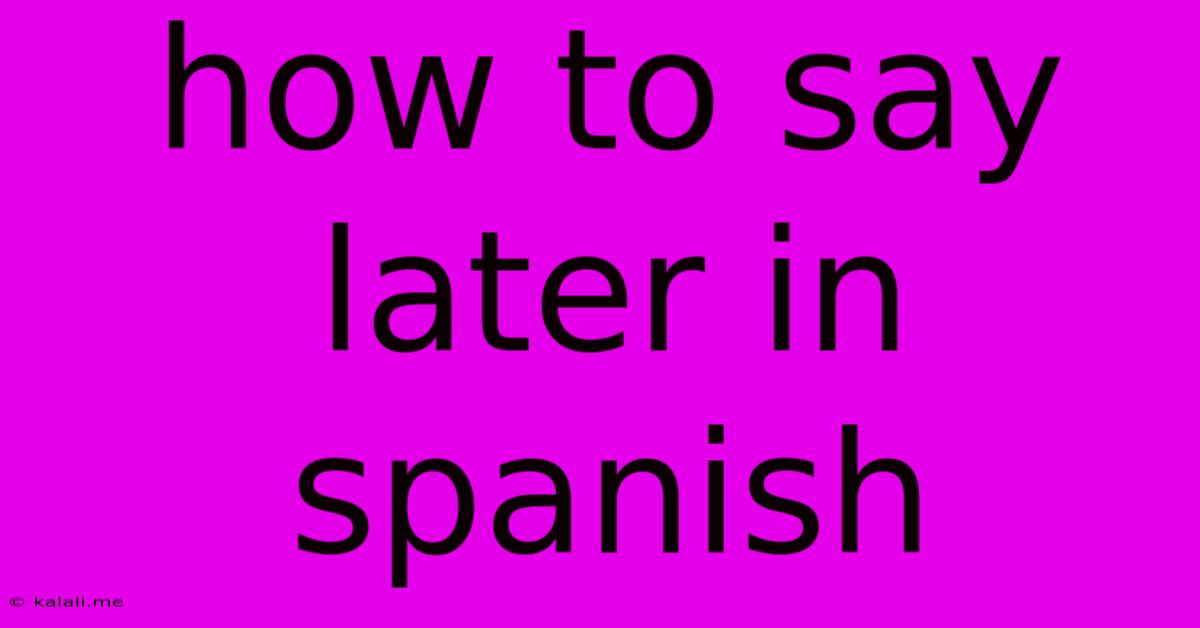How To Say Later In Spanish
Kalali
May 25, 2025 · 2 min read

Table of Contents
How to Say "Later" in Spanish: A Comprehensive Guide
Knowing how to say "later" in Spanish is crucial for navigating everyday conversations. This seemingly simple phrase actually has several translations, each with its own nuance and context. This guide will equip you with the vocabulary and understanding to choose the perfect phrase for any situation.
This article will explore various ways to express "later" in Spanish, covering formal and informal contexts, and helping you understand the subtle differences in meaning. We'll delve into the most common phrases, examining their usage and providing example sentences for clarity. This will ensure you can confidently communicate your plans and intentions in Spanish.
Common Ways to Say "Later" in Spanish
The best way to say "later" depends heavily on the context. Here are some of the most common options:
-
Luego: This is a versatile and widely used word meaning "later" or "then." It's generally suitable for most informal and some formal situations.
- Example: "Te llamo luego." (I'll call you later.)
-
Después: Similar to "luego," "después" translates to "after" or "later." It implies a slightly more definite timeframe than "luego."
- Example: "Hablamos después de la cena." (Let's talk after dinner.)
-
Más tarde: This phrase translates directly to "later" and is a common and widely understood option. It's suitable for both informal and formal settings.
- Example: "Nos vemos más tarde." (See you later.)
-
Pronto: While literally meaning "soon," "pronto" can often be used interchangeably with "later," especially in informal settings where the exact timeframe isn't crucial.
- Example: "Vuelvo pronto." (I'll be back soon/later.)
Choosing the Right Phrase: Context is Key
The choice between these phrases often depends on the level of formality and the specific context of the conversation. "Luego" and "después" are generally interchangeable in informal settings, while "más tarde" tends to sound a bit more formal. "Pronto" implies a shorter timeframe than the other options.
Consider these examples to better understand the nuances:
- Formal setting: "Hablaremos más tarde sobre este asunto." (We will talk later about this matter.)
- Informal setting with friends: "Nos vemos luego, chicos!" (See you later, guys!)
- Referring to a specific time: "Te llamo después de las seis." (I'll call you after six.)
- Expressing an uncertain time: "Te veo pronto." (See you soon/later.)
Beyond the Basics: Other Ways to Express "Later"
While the phrases above cover most situations, there are other ways to express the idea of "later" depending on the specific context. You might use phrases like:
- En un rato: This means "in a while" or "a little later."
- Dentro de un rato: Similar to "en un rato," but perhaps emphasizing a slightly longer wait.
Mastering the subtleties of these different phrases will allow you to communicate more naturally and accurately in Spanish. Remember to practice using these phrases in different contexts to build your confidence and fluency. The more you practice, the more naturally you’ll incorporate these expressions into your conversations.
Latest Posts
Latest Posts
-
How To Stop Cats From Scratching At The Door
May 26, 2025
-
Object Moves X Spaces Get Odometer Python
May 26, 2025
-
How Heavy Was The Cross Jesus Carried
May 26, 2025
-
How To Wire A Outlet And Light Switch
May 26, 2025
-
Blender Instead Of Moving Vertex Moves Whole Object
May 26, 2025
Related Post
Thank you for visiting our website which covers about How To Say Later In Spanish . We hope the information provided has been useful to you. Feel free to contact us if you have any questions or need further assistance. See you next time and don't miss to bookmark.